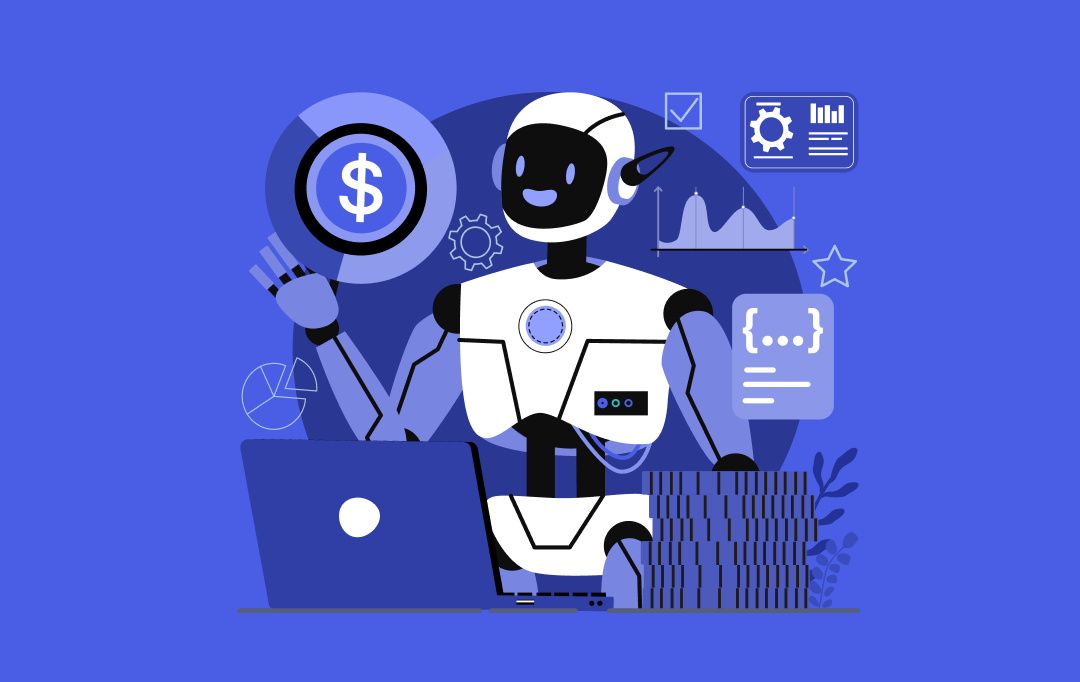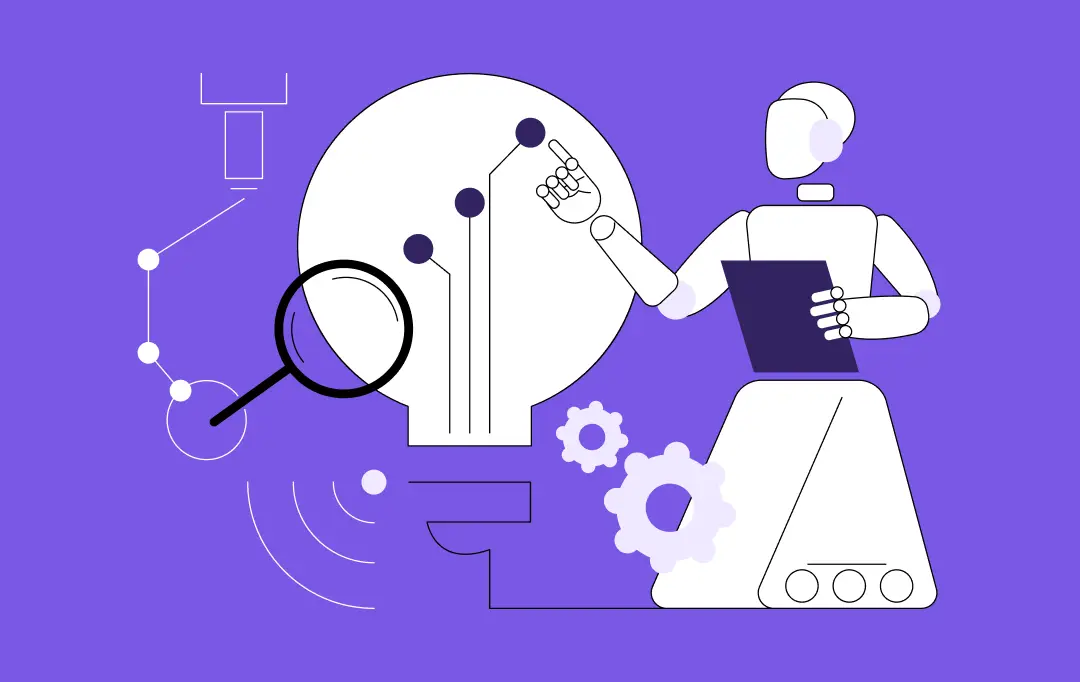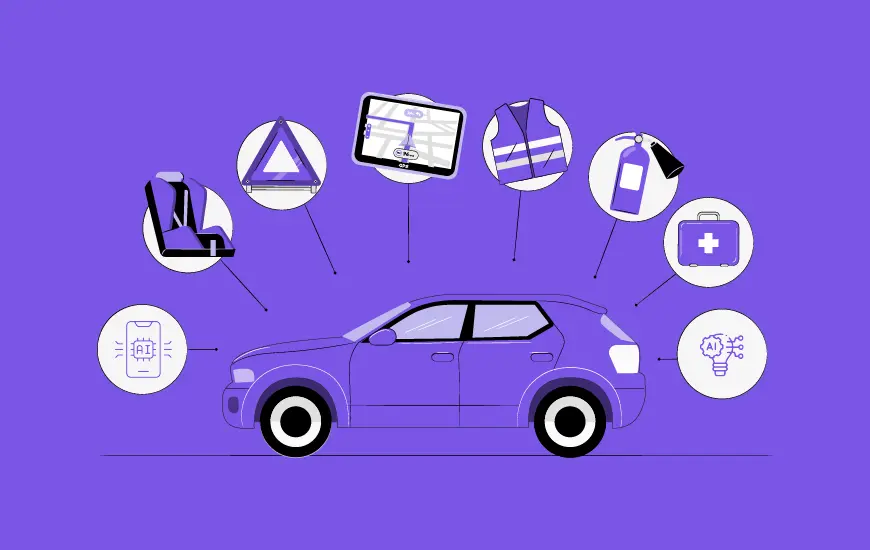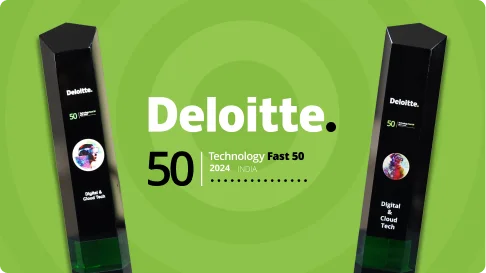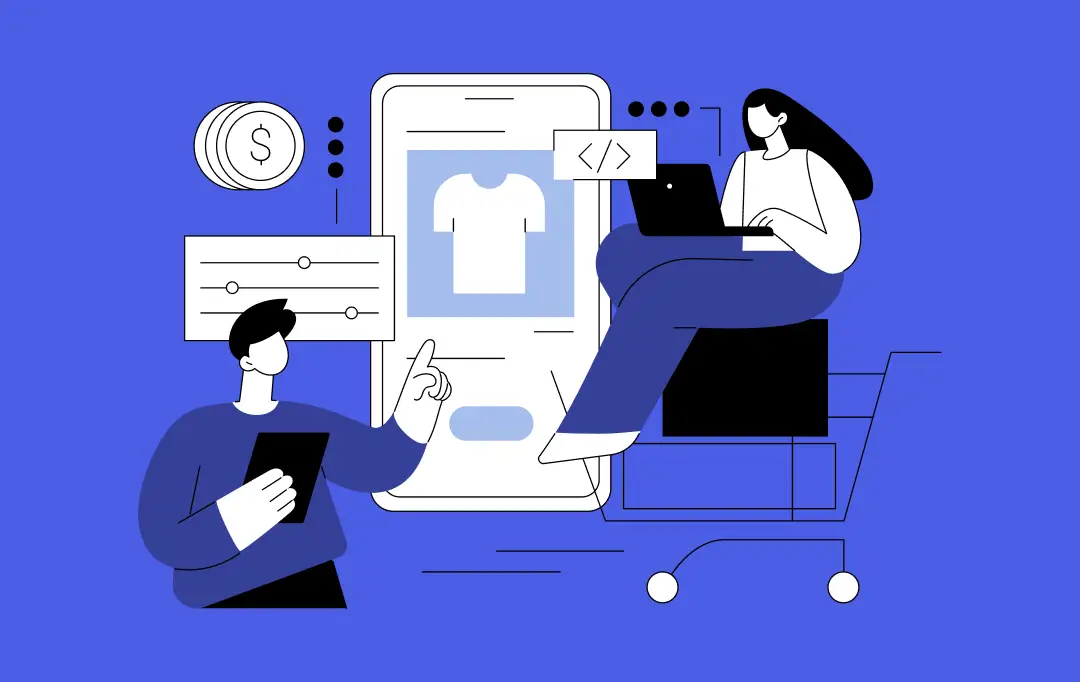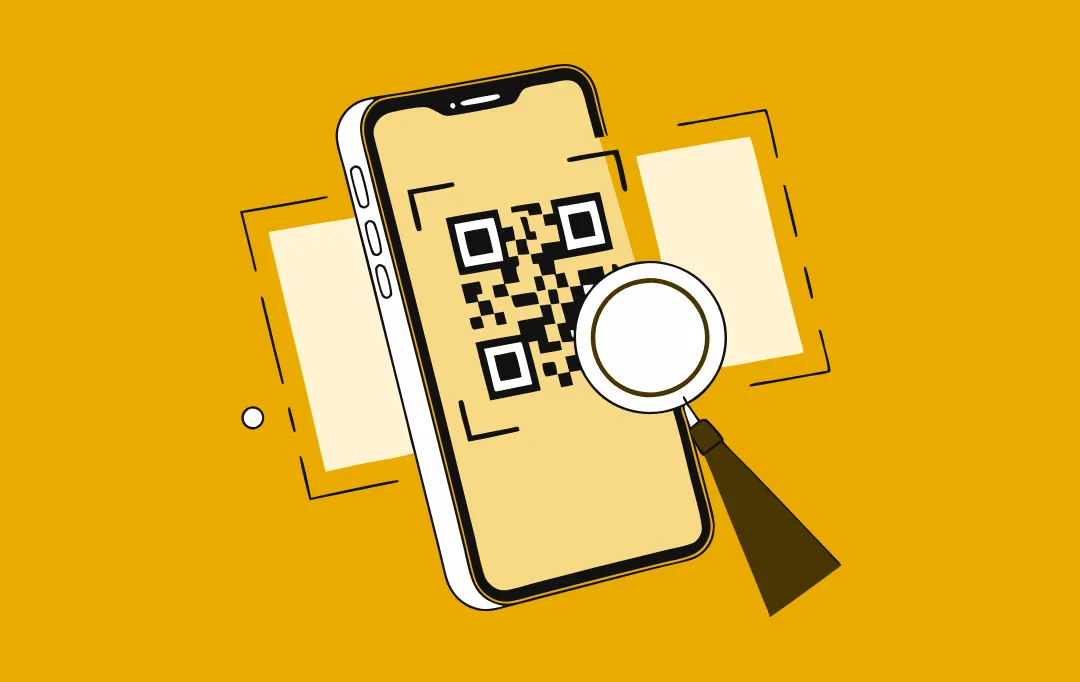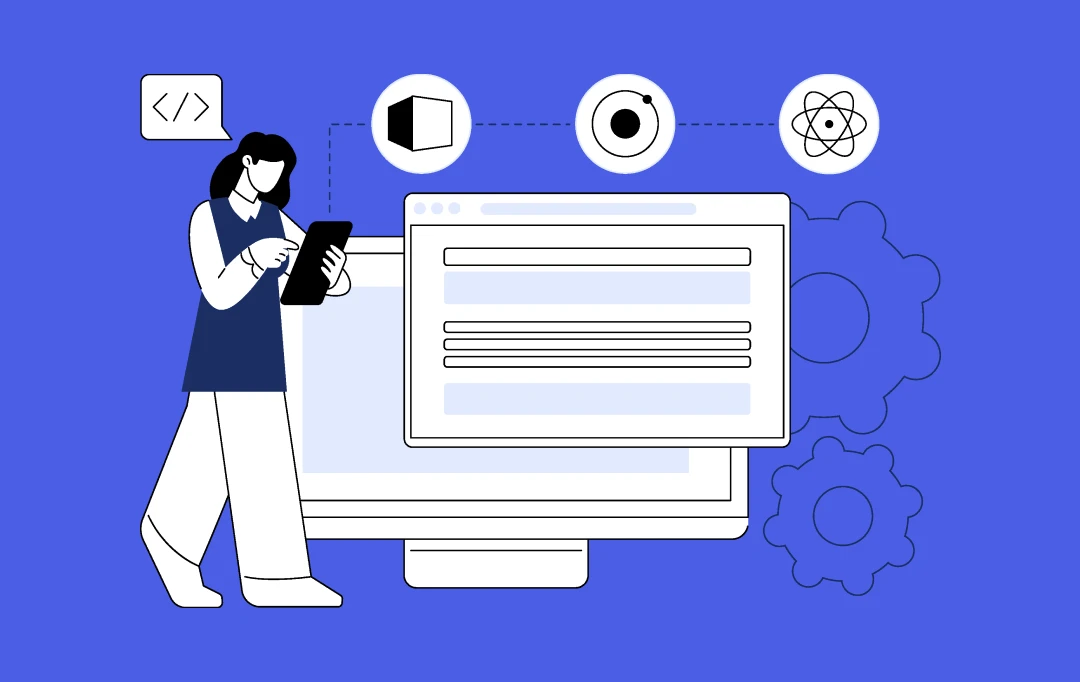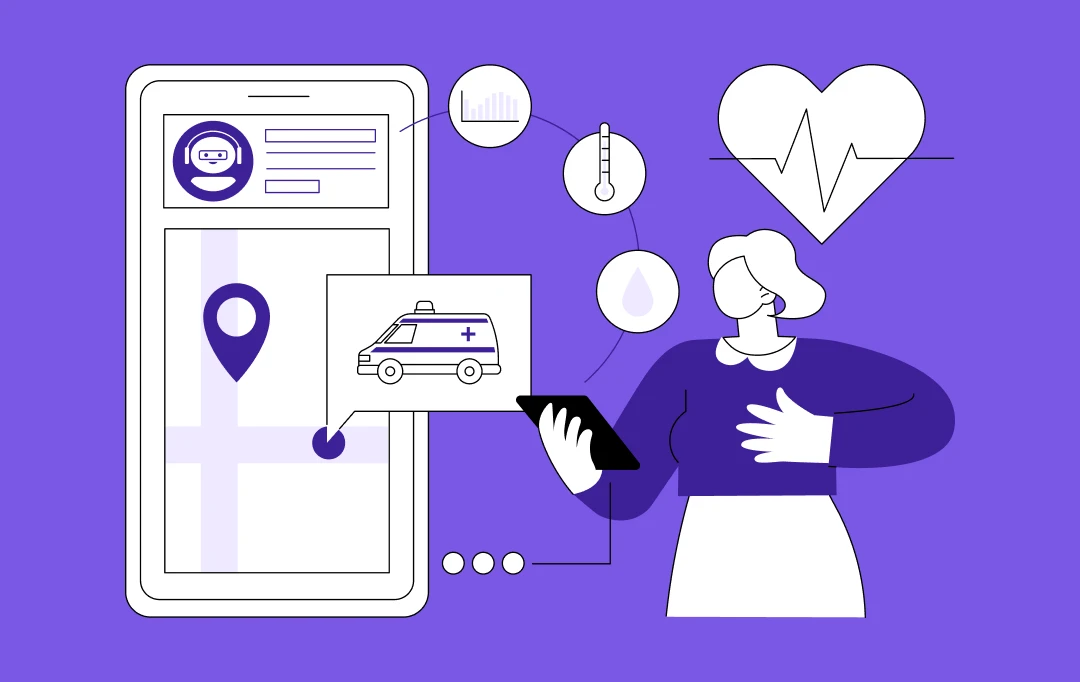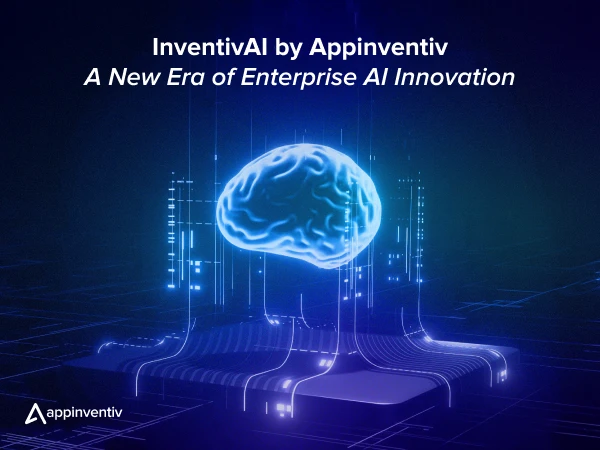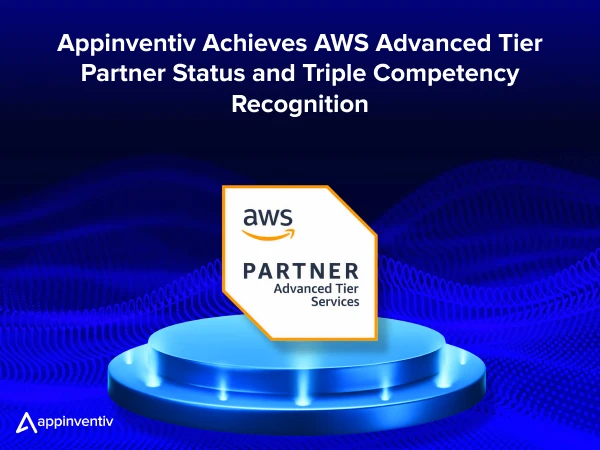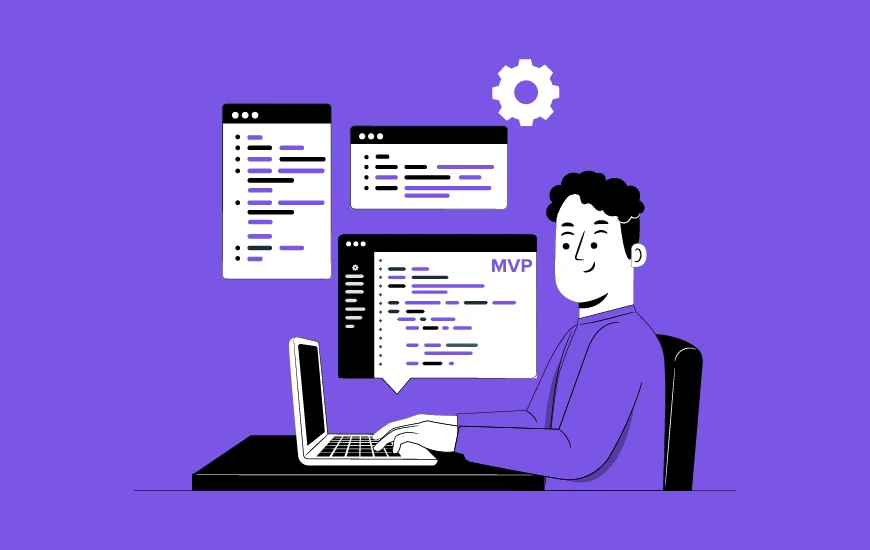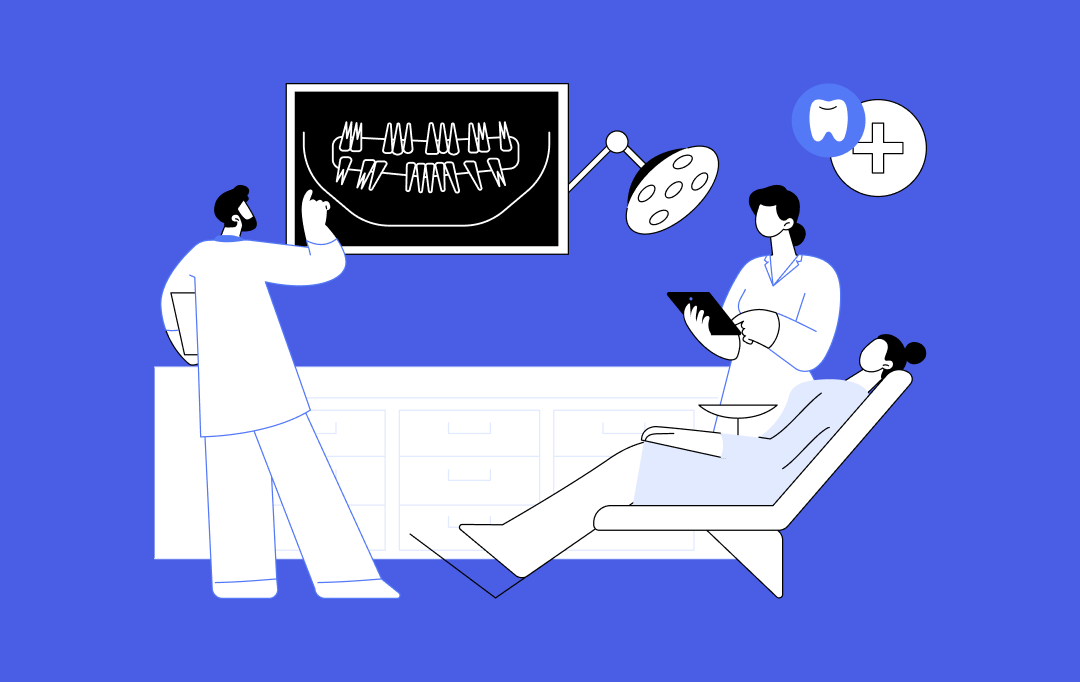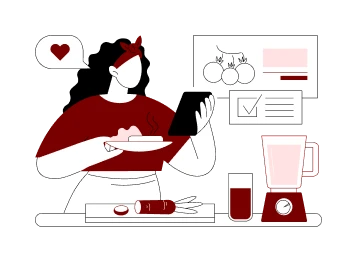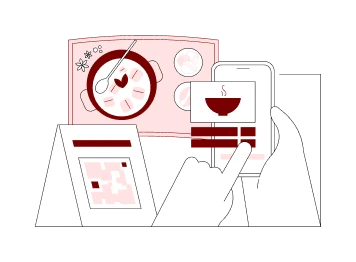- The Cloud Kitchen Market: What’s Changed Since the First Wave
- Inside Kitopi: Business Model, Scale, and Learnings
- Steps to Build a Cloud Kitchen Platform like Kitopi
- Define Your Vision and Business Model
- Understand Your Market Reality
- Design a Purpose-Built Platform Architecture
- Build Features That Reflect Real Kitchen Operations
- Develop the Platform Using a Future-Ready Tech Stack
- Create a Reliable Kitchen Operations Engine
- Layer AI and Automation into the Platform
- Test and Deploy Your Cloud Kitchen Platform Smoothly
- Ensure Compliance, Food Safety, and Data Integrity
- Pilot, Iterate, and Optimize across Kitchens
- Scale With Continuous Innovation
- Cloud Kitchen App Features You Need for a Kitopi-Style Platform
- Must-Have Features of a Kitchen Platform like Kitopi
- Advanced Cloud Kitchen App Features
- Emerging Trends in Cloud Kitchen Platform Management
- How to Set Up a Cloud Kitchen Anywhere in the World
- Choosing the Best Cloud Kitchen Model
- Operational Considerations for Cloud Kitchens
- Technical Requirements for an Efficient Cloud Kitchen
- Cloud Kitchen Platform Development in the UAE: What’s Different
- Cloud Kitchen Platform Development Challenges & Their Practical Solutions
- 2. Ops–Tech Misalignment Inside the Kitchen
- 3. Brand Churn in Multi-Brand Environments
- 4. Navigating Regulations Across Different Markets
- 5. Finding the Right Talent for a Hybrid Operation
- How Much Do Cloud Kitchens Cost?
- Why Do Businesses Invest in Cloud Kitchen Platform Development?
- How to Monetize from A Cloud Kitchen Platform Development like Kitopi
- Subscription Plans for Restaurants
- Renting Kitchen Space (Cloud Kitchen as a Service)
- Commission-Based Earnings
- Delivery & Logistics Fees
- Sponsored Listings & Brand Collaborations
- Virtual Brand Franchising
- Data & Analytics Subscription
- Launch Your Digital-First Cloud Kitchen with Appinventiv
- FAQs
- Q. How does cloud kitchen work?
- Q. How can AI and automation improve cloud kitchen operations?
- Q. How to build a cloud kitchen platform?
- Q. How much does it cost to build a cloud kitchen platform?
- Q. Can a single cloud kitchen run multiple brands?
- Q. Do I need my own delivery fleet?
- Q. What licenses do cloud kitchens require?
- Q. What is the typical timeline for cloud kitchen app development?
Key takeaways:
- Cloud kitchen platform development like Kitopi is now a data-heavy, AI-driven play, not just a “dark kitchen with an app.
- The global cloud kitchen market crossed $78.1B in 2024 and is projected to hit $141.08 B by 2030, with robotics and AI among the core growth drivers.
- A modern cloud kitchen app like Kitopi needs robust architecture, a future-ready cloud kitchen technology stack, and integrated management software for brands, operations, and delivery partners.
- The cost to build a cloud kitchen app and platform typically ranges from $40,000–$400,000+, depending on automation level, AI, integrations, and regions like the UAE, where compliance and localization add complexity.
A few years ago, “cloud kitchen” sounded like a side project. Now it’s a serious operating system for food brands.
The last few years have made one thing very clear: customers don’t care where the kitchen is, as long as the food arrives fast, fresh, and consistent. They tap, order, track and expect restaurant-level quality from a kitchen they will never see.
That shift is showing up in the numbers. According to a report by Grand View Research, the global cloud kitchen market was valued at 73.18 billion in 2024 and is projected to reach 141.08 billion by 2030, growing at a 11.9% CAGR. In regions like the Middle East, growth is even sharper, with the UAE emerging as one of the most competitive cloud kitchen hubs worldwide.
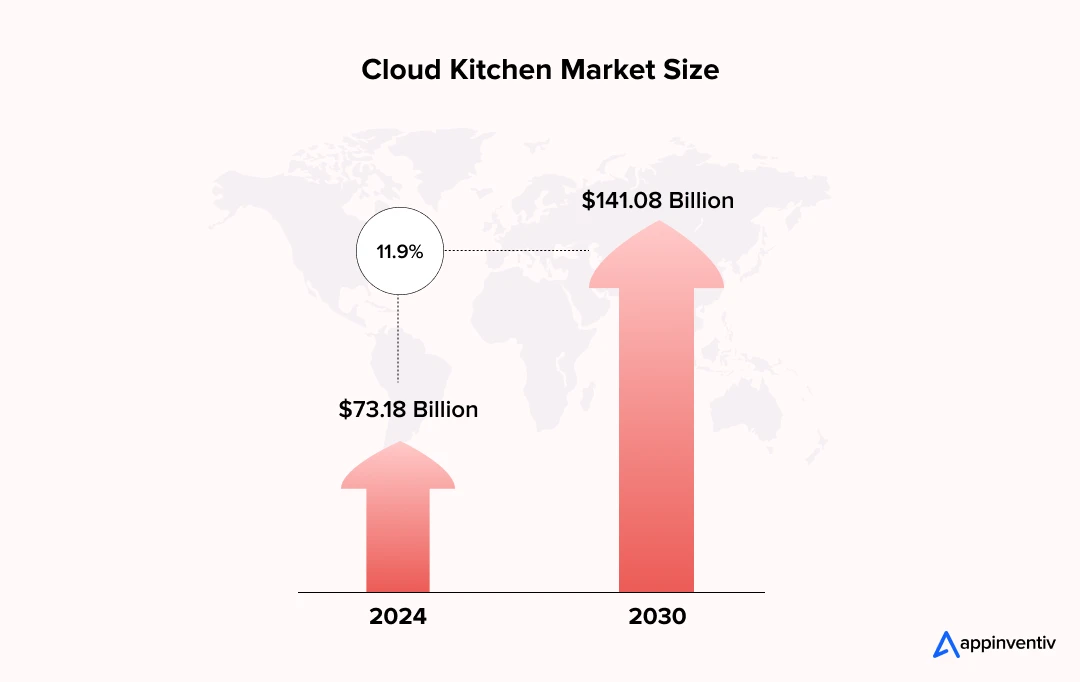
Instead of opening one restaurant at a time, companies are building multi-brand kitchen management platforms that run dozens of virtual brands from a single facility. The ambition is simple: cook smarter, dispatch faster, and turn data into repeat orders. That’s where players like Kitopi have changed the rules and set a new benchmark for cloud kitchen platform development like Kitopi.
If you’re exploring a cloud kitchen app like Kitopi, you’re not just building a food delivery app. You’re creating a backbone that connects kitchen staff, riders, brand owners, aggregators, and customers in real time. The quality of that platform decides whether you scale across cities or struggle to make even one kitchen profitable.
This blog walks you through that journey from a business lens. We’ll break down how the Kitopi business model works, the must-have cloud kitchen app features, the cloud kitchen technology stack behind a scalable platform, and what it realistically takes in terms of the cost to build a cloud kitchen app.
By the end, you’ll be clear on whether you need a simple ordering layer, a full cloud kitchen management software development roadmap, or a Kitopi-style platform that can grow into a multi-brand, multi-city food-tech business, especially if you’re planning cloud kitchen platform development in the UAE.
Global demand is rising fast. The brands winning today are the ones investing in strong operations and smarter tech.
The Cloud Kitchen Market: What’s Changed Since the First Wave
Cloud kitchens started as “low-rent alternatives” to dine-in restaurants. Today, they are full-blown virtual kitchen platform businesses with their own brands, loyal customers, and investor expectations.
Some important shifts you cannot ignore:
- From basic kitchens to AI-enabled systems
Reports now highlight that one of the key growth drivers for cloud kitchens is the integration of robotics and AI for cooking, cleaning, and packing, turning kitchens into software-defined environments. - Automation in the kitchen is no longer experimental
Companies across the Middle East deploy AI-powered robot chefs that handle stir-frying, stewing, seasoning, and self-cleaning. Their robots help restaurants cut labor costs and food waste significantly. - Not every model scales; Reef is the cautionary tale
Some early ghost kitchen players, like Reef Kitchens, have shut down unprofitable kitchen trailers and pivoted towards licensing technology and focusing on more sustainable models. The message is simple: cloud kitchen system development has to be driven by operations and economics, not just hype. - From single-brand to multi-brand portfolio plays
Operators now run multiple virtual brands from the same kitchen, using multi-brand kitchen management app solutions that dynamically route orders, optimize menus, and share ingredients across concepts.
If you are thinking about cloud kitchen software development today, you are not just competing with local restaurants. You are competing with engineered, data-driven food-tech platforms.
Inside Kitopi: Business Model, Scale, and Learnings
Kitopi is widely seen as the Middle East’s flagship cloud kitchen story for a reason. Founded in Dubai in 2018, it has raised over $800 million and achieved unicorn status in 2021 with a valuation of around $1.5 billion.
Key elements of the Kitopi business model:
- Managed cloud kitchens, not just rented space
Kitopi doesn’t just lease a kitchen. It offers a full-stack service: staff, supply chain, production, and technology. Restaurant brands plug into this and focus on menu and marketing. - Smart Kitchen Operating System (SKOS)
Its proprietary SKOS coordinates forecasting, prep, cooking, order batching, and delivery routing. This is the “brain” that every serious Kitopi clone app aspirant needs to think about; copying the UI of a cloud kitchen app like Kitopi is easy; replicating the operating intelligence is not. - Hub-and-spoke operations
Large hubs handle bulk prep; smaller spokes handle finishing and dispatch, keeping food closer to customers while maximizing kitchen utilization. - Hybrid B2B + B2C strategy
Kitopi began as a B2B enabler but now operates 100+ owned or managed brands and 200+ kitchens across the GCC, blending platform revenue with direct consumer brands.
When entrepreneurs ask for a Kitopi clone app, what they really need is clarity on their own version of this model:
- Are you a pure infrastructure player?
- Are you building your own virtual brands?
- Are you a marketplace for other brands with your own delivery fleet?
The right answers here drive everything else; from cloud kitchen revenue model design to cloud kitchen technology stack and monetization plans.
Now that we understand what a cloud kitchen is and how Kitopi operates within this model let’s explore how you can start your cloud kitchen anywhere.
Steps to Build a Cloud Kitchen Platform like Kitopi
Building a cloud kitchen platform development like Kitopi isn’t a linear checklist. It’s a strategic journey that blends technology, kitchen operations, data engineering, and brand management into one scalable ecosystem. Below is a refined, executive-friendly roadmap that reflects how modern cloud kitchen operators actually build platforms today.
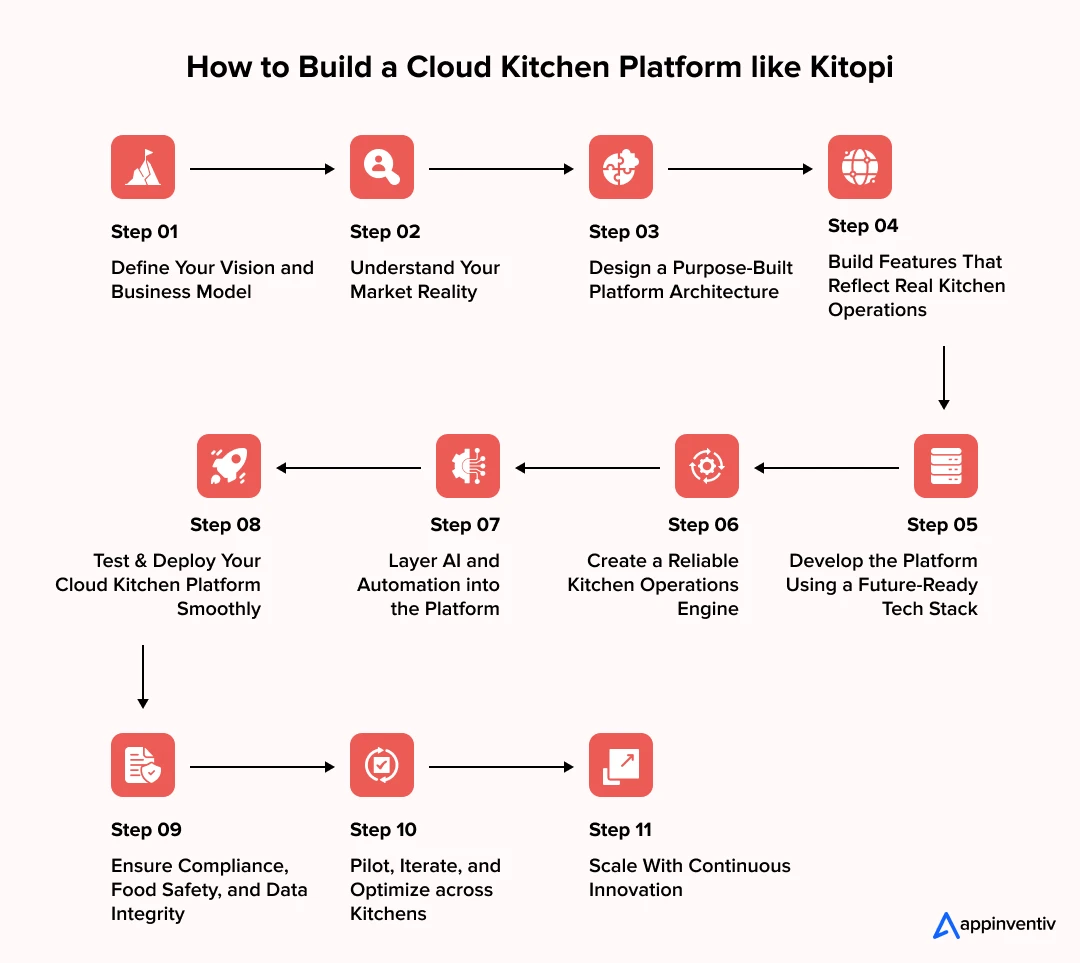
Define Your Vision and Business Model
Before writing a single line of code, you need absolute clarity on what you’re building. A cloud kitchen platform can take several forms:
- A virtual kitchen platform for hosting third-party brands
- A multi-brand kitchen management app supporting your own portfolio
- A hybrid model that combines kitchens, brand management, and delivery operations
Your model decides everything: your cloud kitchen app architecture, the type of automation you’ll build, the scope of your dashboards, and even the cloud kitchen revenue model you will follow.
Brands building a cloud kitchen app like Kitopi typically aim for a full-stack system: kitchen ops, inventory, customer ordering, delivery routing, and multi-brand scaling from day one.
Understand Your Market Reality
After your vision is clear, shift focus to the landscape you’re entering. Each market behaves differently. For instance, cloud kitchen platform development in the UAE demands faster delivery SLAs, deeper aggregator integrations, and stricter food compliance than most regions. Understanding demand density, cuisine gaps, competitor formats, and customer expectations allows you to shape a platform that fits the market instead of forcing the market to fit your platform.
Design a Purpose-Built Platform Architecture
Once the market context is understood, convert your business model into a digital blueprint. A scalable cloud kitchen app architecture should allow customer apps, kitchen screens, rider workflows, brand dashboards, and admin tools to work in sync. Microservices, event-driven communication, separate user roles, and modular APIs form the backbone here. This architectural clarity ensures your platform doesn’t crumble when you add new brands, new cities, or new kitchens.
Build Features That Reflect Real Kitchen Operations
A cloud kitchen isn’t driven by aesthetics; it’s driven by timing, workflow, and precision. Your cloud kitchen app features (details later) should replicate how an actual kitchen runs: orders move from acceptance to prep to cookline to dispatch; inventory reduces in real time; menus adjust dynamically; riders receive optimal routes. When these features are built around operational truth rather than app trends, the platform begins to feel as reliable as Kitopi’s system.
Develop the Platform Using a Future-Ready Tech Stack
Next, translate your blueprint into working software. A modern cloud kitchen technology stack includes backend microservices, cloud computing services, data & storage, real-time messaging, AI and analytics layers. This stage determines whether your platform can handle peak-time load, integrate with aggregators, and offer the stability enterprises expect from a cloud kitchen app development company.
Here is the Ideal Cloud Kitchen Technology Stack You Should Opt for:
| Layer | Technologies / Tools |
|---|---|
| Frontend | – Mobile apps (Flutter, React Native, native iOS/Android) for customers, riders, and staff. – Web dashboards (React, Vue, Angular) for admin and brand partners. |
| Backend & APIs | – Node.js, Java, .NET, or Go-based microservices behind an API gateway. – GraphQL or REST APIs for app communication. |
| Data & Storage | – Relational databases like PostgreSQL or MySQL for orders and transactions. – NoSQL databases for menus, logs, and events.- Data warehouse tools such as BigQuery, Redshift, or Snowflake for analytics. |
| Infrastructure & Cloud Computing Services | – AWS, Azure, or GCP for hosting, scaling, load balancing, storage, and monitoring. – Kubernetes or managed container platforms for deployment. |
| AI & Automation Layer | – AI Models for demand forecasting, dynamic pricing, rider routing, and capacity planning. – Computer vision for quality checks, prep-time prediction, and safety monitoring. |
Create a Reliable Kitchen Operations Engine
Technology alone cannot replicate Kitopi’s precision. Your cloud kitchen system development needs smart kitchen workflows: accurate prep-time logic, station-level routing, inventory governance, and dispatch controls. The result should feel seamless for your kitchen staff: fewer errors, faster turnaround, and predictable output even during rush hours.
Layer AI and Automation into the Platform
At this stage, the platform begins to evolve from functional to intelligent. AI-driven forecasting, dynamic pricing, menu engineering, automated procurement, and delivery optimization transform everyday operations. These capabilities are what ultimately differentiate a simple ordering system from a real cloud kitchen platform development like Kitopi capable of multi-city expansion.
Also Read: AI in Food Delivery App Development
Test and Deploy Your Cloud Kitchen Platform Smoothly
Before going live, your platform needs to be tested under real kitchen conditions; not just inside a development environment. Validate all key workflows: OMS (Order Management System), KDS, rider flows, inventory logic, and aggregator integrations. Once the system performs consistently under load, roll out a controlled pilot in a single kitchen. This limited deployment helps refine prep-time algorithms, UI flows, and dispatch decisions before scaling across multiple locations.
Ensure Compliance, Food Safety, and Data Integrity
Once technology and operations align, bring compliance into the fold. Whether you’re launching in Dubai, Riyadh, or Singapore, local food regulations, data privacy laws, payment mandates, and aggregator requirements need to be coded into your workflows. Ignoring this step can delay scaling more than any technical hurdle.
Pilot, Iterate, and Optimize across Kitchens
Before full deployment, launch a controlled pilot in a single kitchen or limited area. This phase reveals how your OMS, KDS, rider logic, and inventory loops behave under real pressure. Use this data to refine prep-time algorithms, labor planning, and the flow of your cloud kitchen management software development. Once you’re confident in the system’s stability, expansion becomes a strategic rather than operational challenge.
Scale With Continuous Innovation
A Kitopi-style platform is not a build-and-forget product. Its strength lies in constant iteration; improving UI flows, upgrading your tech stack, experimenting with new business models, introducing automation, and optimizing cross-kitchen orchestration. This continuous evolution is what keeps your cloud kitchen app like Kitopi ahead of competitors and ready for new markets.
Cloud Kitchen App Features You Need for a Kitopi-Style Platform
When you look at cloud kitchen platform development like Kitopi, the real magic isn’t in the branding or the UI. It’s in the features that keep kitchens running without chaos. Below is a straightforward, human take on what you genuinely need in a cloud kitchen platform; first the essentials, then the advanced capabilities you add once things begin to scale.
Must-Have Features of a Kitchen Platform like Kitopi
These foundational capabilities ensure your platform runs reliably from day one. Without these, even the smartest business model will struggle to scale.
 Unified
Unified
- Unified Order Management
Your app should pull orders from every channel, your own app, website, and all aggregators, into a single dashboard. This keeps teams focused and helps avoid missed orders during peak hours.
- Digital Kitchen Display (KDS) Access
The app must show live order status, prep steps, and completion timelines so kitchen staff stay in sync. Even simple kitchens need this for predictable, calm workflow.
- Real-Time Inventory Updates
Your app should automatically adjust stock levels based on orders. When an item runs low, the app alerts staff instantly. This prevents stockouts and improves customer satisfaction.
- Easy Menu & Pricing Controls
Brands should be able to edit pricing, menu items, combos, and availability right from the app; no dev support needed. This is essential for any multi-brand kitchen management app.
- Live Delivery Tracking
Customers expect accurate delivery updates. The app should show order preparation, rider assignment, ETA, and live location tracking, reducing manual calls and confusion.
- Brand Partner Dashboard
Brands using your kitchen should have their own login inside the app to view orders, cancellations, payouts, ratings, and performance metrics. It builds trust and strengthens your cloud kitchen revenue model.
- Real-Time Order Tracking (Kitchen + Customer View)
Your app needs a complete tracking layer:
- Kitchen staff see order stage updates (received → prepping → ready → dispatched).
- Customers get live notifications, ETA, and rider location.
- Admins monitor order delays, cancellations, and bottlenecks in real time.
- This single feature reduces support calls, confusion, and delivery-time complaints.
Advanced Cloud Kitchen App Features
Once your core systems are stable, these advanced features push your platform toward Kitopi-level efficiency, automation, and intelligence. These don’t need to go live on day one, but once your platform grows, they make a world of difference.
- AI-Based Forecasting
Your app should learn from past demand, predicting busy hours, popular dishes, or understaffed times. This makes your cloud kitchen platform development like Kitopi, more efficient over time.
- Dynamic Pricing & Menu Testing
Your app should let you test prices, offer time-based discounts, or push promotional menu items. This makes your cloud kitchen a revenue tool; not just an operational one.
- Smart Inventory Automation
Advanced apps come with auto-replenishment alerts, consumption trends, and vendor syncing. Over time, this reduces wastage and lifts margins.
- Optimized Rider Routing
The app should support smarter routing, batching, and assignment to riders to cut delivery time and fuel costs; especially in busy cities like Dubai.
- Location-Aware Kitchen Allocation
For platforms using the hub-and-spoke model, your app should automatically choose which kitchen prepares the order based on distance, load, and stock levels. This is a major advantage when building a Kitopi clone app.
- Deep Analytics & Insights
A strong app doesn’t stop at charts. It should have an intelligent AI analytics feature to show repeat customer behavior, brand-level performance, low-margin dishes, prep delays, and geographical demand patterns; critical during expansion.
- Built-In Quality & Compliance Modules
This feature is especially useful for cloud kitchen platform development in . Your app should support digital hygiene checklists, audit reminders, and compliance workflows, reducing operational risk.
Also Read: 10 Must-Have Features For Your Restaurant App
Emerging Trends in Cloud Kitchen Platform Management
The next wave of cloud kitchen growth will be powered by smarter, faster, and more connected platforms. Here are the trends shaping how modern operators plan their roadmap:
- AI-First Menu Engineering
Platforms are moving toward intelligent menus that adapt themselves. Apps can automatically hide low-margin dishes, spotlight profitable combos, or switch menus during slow hours to improve utilization.
- Robotics Integration
More cloud kitchens are plugging automated fryers, wok stations, and packing tools directly into their operating system. This reduces prep time, cuts errors, and keeps food quality consistent during busy periods; something manual workflows often struggle to maintain.
- Dynamic Pricing & Hyperlocal Experiments
Operators are testing new brands, limited-time dishes, and targeted offers in specific neighborhoods before rolling them out citywide. This helps kitchens avoid risky full-scale launches and refine their strategy based on real-time performance.
- Sustainability as a Competitive Edge
Recyclable packaging options, waste-tracking modules, and sustainability dashboards are increasingly built into platforms. Large enterprises now see environmental standards as part of their customer promise, not just compliance.
- Data Partnerships With Brands
Cloud kitchen providers are shifting from being “just a facility” to being strategic partners. Through performance insights, demand forecasting, and brand-level dashboards, data becomes a service in itself; making cloud kitchen management software development a value multiplier rather than just an operational tool.
These emerging trends in cloud kitchen platform management are what separate a simple kitchen with tablets from a truly investable platform.
From AI forecasting to real-time dashboards, we’ll help you add the features that improve prep speed, reduce waste, and lift margins in the UAE.
How to Set Up a Cloud Kitchen Anywhere in the World
There are several moving parts involved in setting up a cloud kitchen. To make things clearer, let’s break the entire process into three practical segments: choosing the right model, understanding operational needs, and setting up the technical systems that support a modern cloud kitchen platform development like Kitopi.
Choosing the Best Cloud Kitchen Model
Picking the right format lays the foundation for everything that follows, including costs, staff size, and the scope of your cloud kitchen app architecture.
Standalone Kitchen
This is the most popular cloud kitchen model: one brand, one cuisine, and a focused menu. Think of a small pizza kitchen offering 10–15 items. It’s cost-friendly and works well for teams just starting their cloud kitchen app development journey.
Cloud Restaurants
Here, a virtual brand operates inside an existing restaurant. The restaurant’s infrastructure is used to run multiple menus that appear on food aggregators under different brand names. Many businesses use this model before moving toward full-fledged cloud kitchen system development.
Co-working Cloud Kitchen
These are large facilities divided into independent units, rented by multiple restaurant brands. It’s ideal for teams running several concepts under one roof and pairs naturally with a multi-brand kitchen management app.
Aggregator Cloud Kitchen
This model is an extension of co-working kitchens but built specifically for delivery-only brands. Operators rely heavily on aggregator platforms to manage deliveries, making this format suitable for brands looking to scale without handling logistics in-house.
Here is an estimated cloud kitchen platform development cost by model. This will help you make the right choice.
| Cloud Kitchen Model | Platform Development Cost |
|---|---|
| Standalone Kitchen | 420,000+ |
| Cloud Restaurant | $40,000+ |
| Co-working Cloud Kitchen | $50,000+ |
| Aggregator Cloud Kitchen | $55,000+ |
Actual cloud kitchen platform cost varies based on your features, integrations, regions, and automation level (details later).
Operational Considerations for Cloud Kitchens
Location
Unlike traditional restaurants, cloud kitchens don’t rely on foot traffic. The priority is speed. Your kitchen should be close to areas where most orders will come from. Residential zones, commercial clusters, unused parking spaces, and even food trucks can work. This helps your cloud kitchen app like Kitopi maintain fast delivery times.
License & Compliance
Certifications and food safety licenses are essential, especially when customers can’t physically see your kitchen. This is even more critical for teams working on cloud kitchen platform development in the UAE, where hygiene checks and municipal approvals are mandatory.
Kitchen & Packaging Equipment
Your equipment depends on your cuisine and menu size. A simple setup may only need a fridge, stove, oven, and prep counters. Packaging, however, deserves special attention. Even great food loses appeal if the packaging fails; leaking boxes and soggy meals quickly hurt your brand.
Kitchen Staff
Since cloud kitchens don’t require front-of-house staff, your focus is on reliable cooks and cleaners. A small, well-trained team can support early operations while ensuring hygiene standards stay consistent.
Technical Requirements for an Efficient Cloud Kitchen
A modern cloud kitchen relies heavily on technology. This is where your cloud kitchen management software development decisions create real operational impact.
Point of sale (POS) System
A smart POS gathers orders from aggregators, your website, and your app in one place. It helps analyze which platforms perform best and supports smoother cloud kitchen platform development like Kitopi by reducing manual work.
Online Ordering Software
Relying solely on aggregators increases commission costs. Building your own online ordering web or mobile app, linked with your POS and KDS, creates direct customer relationships and improves margins. This is a major pillar of effective cloud kitchen software development.
Integrated Kitchen Display System (KDS)
A KDS helps the kitchen staff track, prepare, and dispatch orders efficiently. It shows expected prep times, identifies delays, and keeps the workflow transparent; key for any expanding virtual kitchen platform.
Food Delivery System
You can either manage delivery in-house or rely on third-party food ordering and delivery applications. With an internal delivery system, you have more control but also more operational responsibility. With aggregators, your platform assigns orders automatically to the nearest delivery person, improving delivery consistency inside your cloud kitchen app like Kitopi.
Inventory Management System
Daily ingredient tracking is critical. An AI powered inventory management system helps you plan purchases, lower wastage, and maintain consistency. This system becomes even more important as you expand kitchens and introduce automation into your cloud kitchen system development roadmap.
Cloud Kitchen Platform Development in the UAE: What’s Different
The UAE cloud kitchen market was around $276.62 million in 2023 and is projected to reach $1.28+ billion by 2032, at a CAGR of 25.17%. This makes cloud kitchen platform development in the UAE uniquely attractive and also competitive.
Specific considerations:
- High aggregator presence – Food delivery apps like Talabat, Deliveroo, Careem, Noon, and others dominate customer attention. Your cloud kitchen app development must prioritize seamless aggregator integrations and performance analytics.
- Regulatory clarity – Dubai and Abu Dhabi are fairly progressive on licensing and innovation zones, but you still need robust documentation and compliance workflows built into your platform.
- Premium consumer expectations – Faster delivery, better packaging, and more diverse cuisines mean your virtual kitchen platform needs strong UX and high reliability.
- Regional expansion – Most UAE-based operators see the country as a beachhead into KSA, Qatar, Bahrain, and beyond, so build your cloud kitchen app architecture with multi-country configurations in mind.
So, if you’re exploring cloud kitchen platform development in the UAE, the bar is high but so is the upside.
Cloud Kitchen Platform Development Challenges & Their Practical Solutions
Building a cloud kitchen platform development like Kitopi can unlock tremendous scale, but the journey isn’t without its bumps. Most issues arise not from the kitchen itself, but from the systems, processes, and people that keep it running. Here are the most common challenges operators face, along with realistic solutions that prevent costly setbacks later.
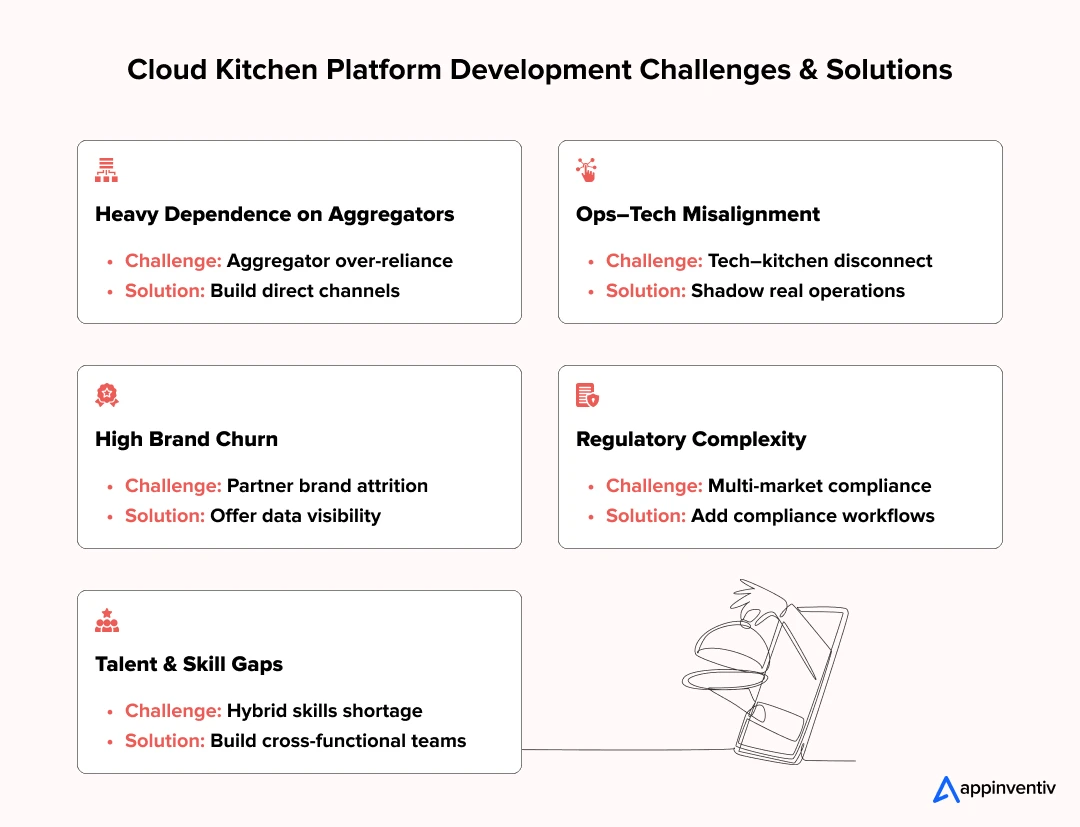 1. Heavy Dependence on Aggregators
1. Heavy Dependence on Aggregators
The challenge: Relying too much on third-party marketplaces reduces margins and limits customer visibility. Your brand becomes searchable, but not necessarily memorable.
The solution: Build your own ordering channels early. A direct web or mobile app for your restaurant business reduces commissions and gives you control over customer data. As your cloud kitchen app development matures, these channels naturally grow into your strongest asset.
2. Ops–Tech Misalignment Inside the Kitchen
The challenge: Product teams often design features without understanding the reality of a live kitchen. This leads to workflows that look good on screen but fall short during peak rush.
The solution: Have your tech and product teams shadow kitchen staff. Let them observe prep times, bottlenecks, and real-time decision-making. This ensures the cloud kitchen management software development aligns with how kitchens actually work.
3. Brand Churn in Multi-Brand Environments
The challenge: When partner brands don’t see results within a few months, they leave. This churn hurts the unit economics of multi-brand kitchens.
The solution: Build the platform with transparent dashboards, profitability insights, and menu-level analytics. A strong cloud kitchen platform development like Kitopi supports brands with data, not just kitchen space.
4. Navigating Regulations Across Different Markets
The challenge: Food safety, zoning rules, halal certifications, and packaging standards differ across regions, especially when expanding from the UAE to markets like KSA, the EU, or the US.
The solution: Build compliance workflows into your cloud kitchen system development. Digital checklists, automated audits, and region-wise configuration options make expansion smoother.
5. Finding the Right Talent for a Hybrid Operation
The challenge: A cloud kitchen is not purely F&B or purely tech. It’s a mix of kitchen operations, logistics, data, and engineering. Few teams have this blend.
The solution: Build a leadership team that understands both worlds. Partner with a reputed Dubai app development firm to build and maintain the system and train kitchen staff on tech tools. The more balanced the culture, the stronger the platform.
Addressing these challenges early gives your platform a far better chance of growing into a system that behaves like Kitopi: reliable, fast, and scalable.
How Much Do Cloud Kitchens Cost?
For a serious, multi-tenant platform with customer apps, brand dashboards, rider apps, and admin consoles, the cost to build a cloud kitchen app and backend platform typically starts around $40,000–$120,000 for an MVP and can go as high as $400,000 or more with:
- Advanced AI modules
- Deep integrations (POS, ERP, loyalty systems)
- Complex analytics and reporting
- Multi-country tax, language, and pricing rules
You’ll often see this bundled under cloud kitchen software development, which covers mobile apps, web portals, APIs, and devops. Once you factor in physical setup, a more realistic cloud kitchen platform cost range looks like:
| Component | Estimated Cost (USD) |
|---|---|
| App & Website Development | $40,000 – $120,000 |
| Kitchen Infrastructure Setup | $20,000 – $100,000 |
| Equipment & Utilities | $20,000 – $80,000 |
| Licenses & Permits | $5,000 – $20,000 |
| Marketing & Branding | $5,000 – $30,000 |
| Delivery & Logistics Setup | $10,000 – $50,000 |
| Total Estimated Cost | $100,000 – $400,000 |
The final cost depends on the scale of the operation, location, level of technology integration, and business model. If you plan to include AI-driven automation, smart inventory management, and advanced analytics, the cost will be on the higher end of the spectrum.
For multi-kitchen expansion with automation, it’s common for total investment to cross $1100,000–$600,000+.
This is why most enterprises look beyond one-time app build and think in terms of long-term cloud kitchen system development and optimization.
Also Read: How Much Does It Cost to Build a Food Delivery App Like HungerStation?
From MVP to full-scale platform, we’ll help you estimate the real cost, timelines, and roadmap for building your cloud kitchen system. No vague quotes; only clarity.
Why Do Businesses Invest in Cloud Kitchen Platform Development?
Businesses don’t invest in cloud kitchens just because the category is hot. They invest because a well-built cloud kitchen platform development like Kitopi behaves more like a scalable digital product than a traditional restaurant business. Here are some of the most lucrative benefits that give businesses good reasons to opt for cloud kitchen management software development in Dubai, UAE
Lower Upfront Costs
Opening a physical restaurant requires heavy capex like interiors, staff, and real estate. A cloud kitchen shifts that cost toward technology and operations, reducing risk from day one.
Rapid Menu and Brand Experimentation
With a flexible virtual kitchen platform, brands can test new cuisines, pricing, and combos without opening new outlets. If something doesn’t work, it can be changed instantly.
Better Unit Economics Over Time
As your routing, prep-time logic, inventory, and delivery processes mature, margins improve. This is where the right selection of cloud kitchen technology stack makes a real difference.
Clear, Real-Time Data Visibility
Brands get transparent insights across channels, kitchens, and cities. This level of visibility is impossible with traditional restaurants.
Scalability Similar to SaaS
Once the platform works for one kitchen, it can be replicated in five, ten, or fifty with the same operational backbone. That’s the power of software-driven kitchens.
In simple terms, a modern cloud kitchen turns food production into a digitally managed, operationally consistent engine. Instead of running a restaurant, you’re running a scalable, intelligent system; much closer to SaaS than old-school F&B.
How to Monetize from A Cloud Kitchen Platform Development like Kitopi
Cloud kitchens rely on digital-first operations, allowing multiple revenue streams beyond just selling food. By leveraging a combination of these strategies, cloud kitchen operators can create multiple revenue streams and build a scalable, profitable business. Here are some effective ways to generate revenue from a cloud kitchen platform. Under these revenue models you can:
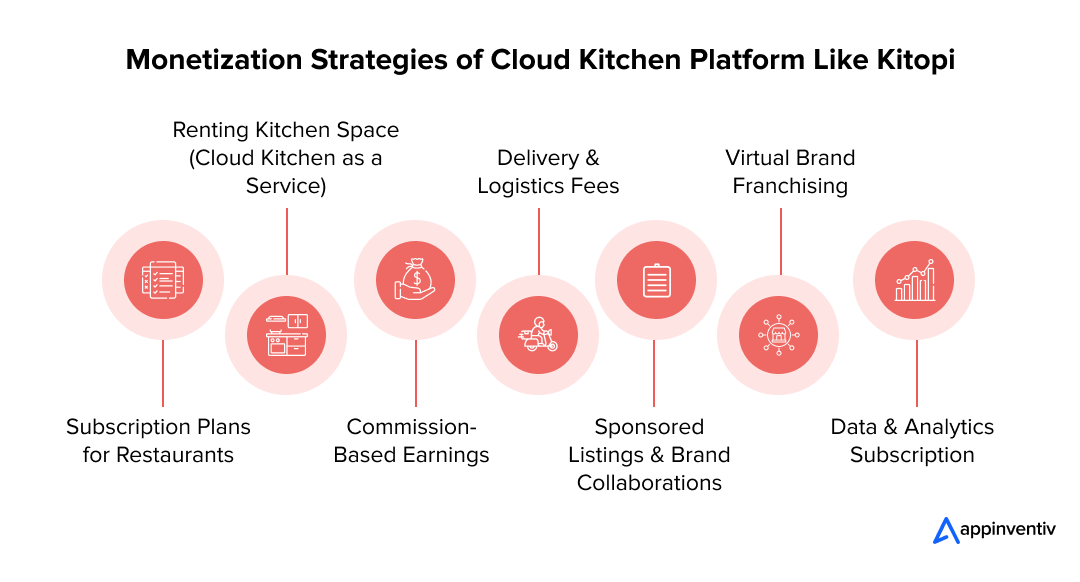
Subscription Plans for Restaurants
Offer tiered subscription plans where restaurants pay a fixed monthly or annual fee to access platform features like order management, analytics, and marketing tools.
Example: Charging $200- $1,000 per month for premium services.
Renting Kitchen Space (Cloud Kitchen as a Service)
Lease out fully equipped kitchen spaces to food brands or startups that want to operate without investing in physical locations.
Example: Renting kitchen space for $2,000–$10,000 per month, depending on size and equipment.
Commission-Based Earnings
Charge restaurant partners a percentage of every order placed through the platform. This is a common revenue model for food aggregators.
Example: Taking a 15-30% commission per order.
Delivery & Logistics Fees
Charge restaurants or customers for delivery services through a flat rate or distance-based pricing model. Some platforms also offer fleet management as an additional service.
Example: Charging $2–$5 per delivery or using dynamic pricing based on distance.
Sponsored Listings & Brand Collaborations
Allow restaurants or food brands to pay for better visibility on the platform, such as top search rankings or featured placements.
Example: Charging $500–$5,000 monthly for priority listings and promotions.
Virtual Brand Franchising
Develop proprietary cloud kitchen brands and license them to food entrepreneurs or restaurants that want to expand without setting up physical space.
Example: Franchise fees between $10,000–$50,000, plus a percentage of revenue.
Data & Analytics Subscription
Sell insights and analytics on customer behavior, peak order times, and menu optimization to restaurants looking to improve their operations.
Example: Charging $100–$1,500 monthly for business intelligence reports.
Launch Your Digital-First Cloud Kitchen with Appinventiv
Building a cloud kitchen platform development like Kitopi takes more than clean code. It requires an understanding of kitchen workflows, delivery dynamics, regulatory demands, and the realities of scaling across regions like the UAE and KSA. This is exactly where Appinventiv stands out.
With over a decade of experience in the Middle East, our team of 1600+ tech experts has helped food-tech operators, restaurant giants, and delivery-first brands turn their ideas into scalable platforms, combining strong engineering with practical, on-ground experience.
Here’s the impact we’ve created in the region:
- 1,000+ digital projects delivered across the Middle East
- 150+ restaurant and food-tech platforms launched
- 40% increase in operational efficiency through automation
- 500+ enterprise workflows modernized
- 99.9% uptime for mission-critical restaurant platforms
Being recognized as a Deloitte Technology Fast 50 company in 2023 and 2024, Leader in AI Product Engineering & Digital Transformation by the Economic Times and a Clutch Global Award winner reinforces the quality and consistency we bring to every project, especially in fast-moving industries like food delivery and cloud kitchens.
But what speaks louder than awards is client trust. Our partnerships with global QSR (Quick Service Restaurant) leaders reflect this trust clearly. For instance:
- With Pizza Hut, we redesigned the mobile experience to support their Middle East expansion. A sharper UI/UX flow and a more intuitive ordering journey resulted in a 30% rise in conversion rates and 50K+ new app downloads.
- For KFC, we built a scalable digital ecosystem across seven global markets, enabling the platform to process 30K+ daily orders while improving conversions by 22%.
- With Domino’s, our UX overhaul created a seamless ordering experience that contributed to a 23% increase in conversions and a 4.4-star app store rating.
So, whether you’re launching a single virtual brand or designing a multi-brand ecosystem similar to Kitopi, we help you build the right cloud kitchen app architecture, integrate the right systems, and create a platform that can grow city by city without breaking.
We hope that everything we covered in this blog is enough to help get you started on your aspirations to become a cloud kitchen owner with utmost confidence. There’s only one thing left to do now. Contact the Appinventiv team of restaurant app engineers and initiate your journey.
FAQs
Q. How does cloud kitchen work?
A. Cloud kitchens are a type of centralized commercial food production facility where more than one restaurant can rent space for preparing delivery-optimized cuisines. A single restaurant may have multiple brands under it, all operating under a single roof. Cloud kitchen is all about featuring a large warehouse with numerous mini restaurants stationed with stainless steel prep tables, stoves, hood vents, sinks, and ovens, each having its own order coming from different customers.
Cloud kitchen platform development like Kitopi is highly tech-enabled and they take advantage of the ubiquitous food delivery on your smartphones like Grubhub, Uber Eats, and Doordash.
Q. How can AI and automation improve cloud kitchen operations?
A. AI changes the way kitchens plan their day. With enough order history, the system can estimate rush hours, ingredient usage, and staffing needs. It also identifies patterns such as slow-moving dishes or locations that need extra riders.
Automation supports this by streamlining repetitive tasks; tracking prep times, updating stock, reminding staff of quality checks, or allocating orders to the right station. Together, they make the kitchen smoother, quicker, and far more predictable.
Q. How to build a cloud kitchen platform?
A. Here is a step-by-step process on how to build a cloud kitchen platform.
- Opt for a cloud kitchen model including stand-alone kitchens, cloud restaurants, aggregator kitchens, and co-working cloud kitchens.
- Choose a setup location, as a cloud kitchen cannot work without a specific kitchen space
- Get the proper license required to run your cloud kitchen and stay legally secure
- Hire experienced kitchen staff
- Gather all the kitchen equipment required for preparing cuisine and serving your customers
- Hire a software development partner
- Integrate inventory management and restaurant management system
- Integrate payment, CRM, and POS systems
- Integrate the order management system
- Test and promote
Q. How much does it cost to build a cloud kitchen platform?
A. Costs depend on the number of features and the scale of operations. For instance:
- A simple platform with ordering, KDS, dashboards, and delivery tracking features often costs around $40,000 and $100,000.
- More advanced setups with multi-brand flows, AI forecasting, aggregator integrations, or multi-region capability often fall in the $100,000–$200,000+ range.
- An enterprise-grade advanced application with full scale functionalities typically costs between $200,000 and $400,000 or more.
- If you’re expanding across cities or operating multiple kitchens, ongoing enhancements and automation also add to the long-term investment.
Q. Can a single cloud kitchen run multiple brands?
A. Yes, and in most cases, that’s where cloud kitchens see the best returns. One physical space can run several virtual brands because technology routes orders, assigns stations, and tracks inventory across menus. When this is set up properly, the same staff and equipment can support multiple cuisines without creating confusion.
Q. Do I need my own delivery fleet?
A. You can operate with your own riders, rely on delivery partners, or use a mix of both. Many kitchens begin with aggregators because it’s simpler and then gradually bring delivery in-house for areas with consistent demand. A good platform should support both options and automatically decide which rider is best suited for each order.
Q. What licenses do cloud kitchens require?
A. Most regions require food safety certification, hygiene permits, and local municipal approvals. Some countries also have rules around packaging, waste management, or halal certifications. In places like the UAE, kitchen inspections and compliance checks are strict, so it’s essential to finish them before onboarding brands or going live.
Q. What is the typical timeline for cloud kitchen app development?
A. A basic MVP can go live in 8–12 weeks, especially if the initial scope is clear. A more detailed, multi-brand, multi-location platform, similar to what large operators run, usually takes 4–6 months.
The actual cloud kitchen platform development timeline depends on integrations, automation layers, regional requirements, and how early you involve your kitchen operations team in the process.


- In just 2 mins you will get a response
- Your idea is 100% protected by our Non Disclosure Agreement.

How Cloud Services Accelerate Product Development for Businesses
Key takeaways: Cloud product development changes the speed, cost, and risk profile of modern software delivery. The cost of cloud product development ranges between $40,000 and $400,000 or more. Cloud platforms give you instant access to AI/ML, edge computing, and advanced analytics without dropping tons of money upfront. Appinventiv supports enterprise cloud product development through…
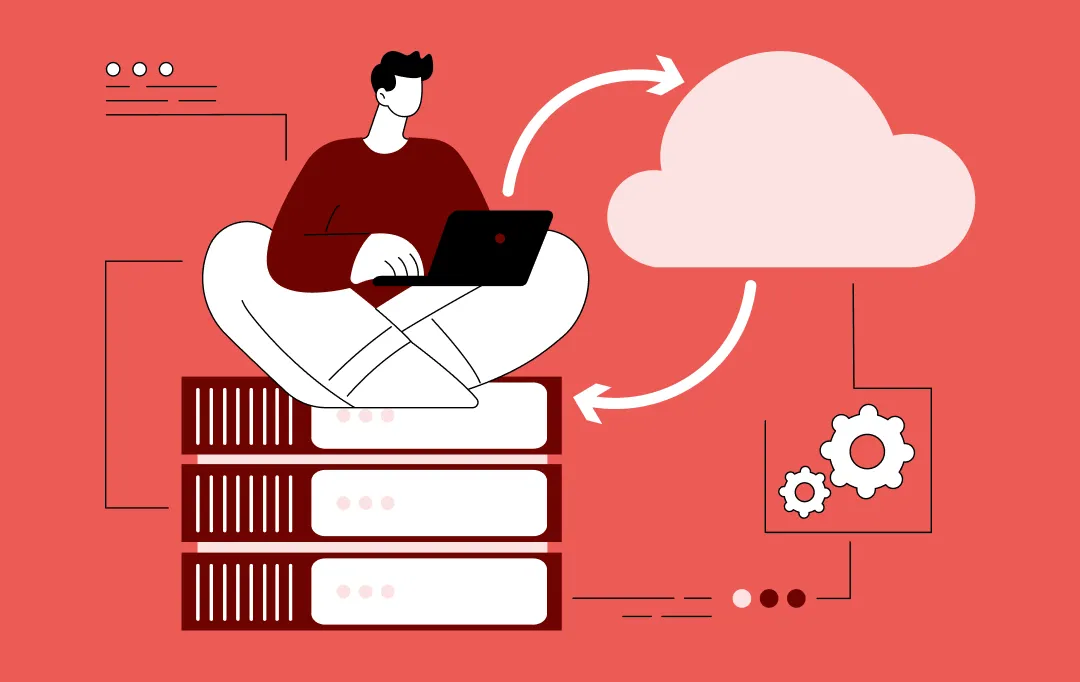
Green Cloud - How Cloud Adoption Helps Improve Sustainability/ESG Goals of Enterprises
Key takeaways: Adopting green cloud solutions lowers energy consumption, cuts emissions, and reduces operational costs. Companies like UEM Edgenta and Bharti Airtel have seen measurable improvements in sustainability and efficiency. AI Enhances Green Cloud Efficiency. AI optimizes energy use, predicts demand, and minimizes waste in cloud infrastructure. Your Green Cloud Roadmap. Start with an infrastructure…
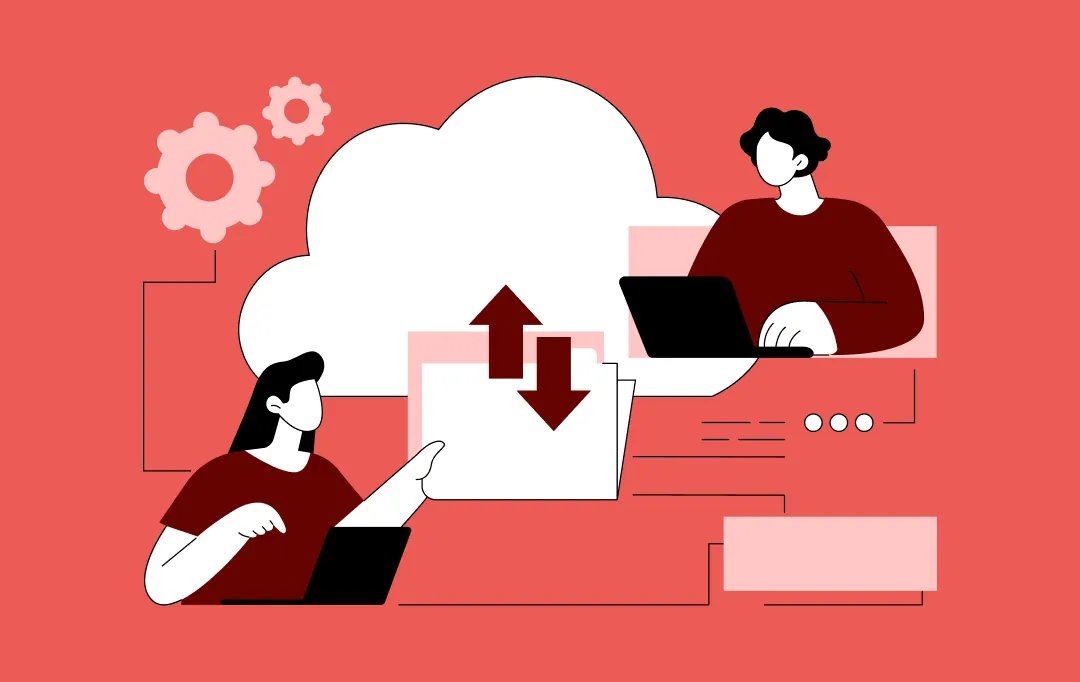
Cloud Migration Strategy for Enterprises in Australia: Benefits, Implementation Process and Tools
Key takeaways: Cloud migration in Australia is accelerating as enterprises modernize aging systems and prepare for AI-driven workloads. Local cloud regions in Sydney, Melbourne and Brisbane make compliance and performance far easier for large-scale migrations. A strong cloud migration strategy for enterprises in Australia depends on clear assessment, the right tools and ongoing optimization. Industry…
